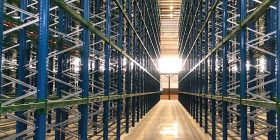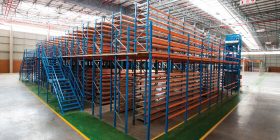Selecting the optimal racking solution for your warehouse can significantly enhance operational efficiency and inventory management. In this article, we delve into the key differences and benefits between Very Narrow Aisle (VNA) racking and Drive-In racking systems. We aim to guide warehouse managers and business owners through the decision-making process, highlighting how Krost Shelving’s innovative racking solutions can meet diverse warehousing needs.
The Differences of VNA Racking and Drive-In Racking Systems
In the difference between VNA racking and Drive-In racking systems, it’s crucial to consider how each utilises warehouse space. VNA racking, with its very narrow aisles, is designed to maximise vertical storage and reduce floor space usage. This system requires specialised handling equipment to navigate the tight spaces. Conversely, Drive-In racking systems are built for bulk storage with a setup that allows forklifts to drive directly into the racking bay. This method significantly reduces the need for multiple aisles and is optimised for storing large quantities of similar items, making it ideal for businesses that need to maximise their storage capacity without concern for immediate access to individual pallets.
VNA Racking: Maximising Space and Efficiency
Very Narrow Aisle (VNA) racking is designed to optimise space utilisation within your warehouse. By reducing aisle width to the minimum, VNA racking maximises storage capacity, making it an ideal choice for facilities with limited space. The VNA Racking (Very Narrow Aisle) vs. Drive-in Rackings differences are significant, with VNA systems requiring specialised handling equipment to navigate the narrower aisles. This system is best suited for environments where high-density storage and rapid access to pallets are critical.
Drive-In Racking: Cost-Effective Bulk Storage Solution
On the other hand, Drive-In racking offers a more cost-effective solution for storing large quantities of similar products. With this system, pallets are stored in a continuous block with aisles eliminated, allowing the forklift to drive directly into the bay. This setup is perfect for businesses that operate on a “last in, first out” (LIFO) inventory basis and is highly beneficial for items that are not time-sensitive but require bulk storage.
Comparing VNA Racking and Drive-In Racking Benefits
The choice between VNA and Drive-In racking systems hinges on several factors. The VNA Racking (Very Narrow Aisle) vs Drive in Rackings benefits include improved space utilisation and faster access to pallets with VNA, while Drive-In racking excels in reducing overall storage costs and enhancing pallet density.
Space Utilisation and Accessibility
VNA racking’s primary advantage lies in its ability to increase vertical storage space while minimising aisle width, thereby utilising the vertical space more efficiently. This design promotes better organisation and easier access to individual pallets, enhancing inventory management and retrieval times.
Cost and Inventory Management
Drive-In racking systems are generally less expensive per pallet stored, making them an economical choice for high-volume storage. However, this system may require more time for accessing specific pallets, which can affect retrieval times and inventory rotation, making it particularly suitable for products with longer shelf lives or those that do not require immediate dispatch.
Choosing the Right Industrial Racking System for Your Warehouse
Deciding on the right industrial racking system involves assessing your specific operational requirements, including the type of goods stored, inventory turnover, and warehouse space. For businesses with high SKU numbers and fast turnover, a VNA Racking (Very Narrow Aisle) system might be more beneficial. In contrast, Drive-In racking could be the solution for companies needing high-capacity storage and reduced handling times. Additionally, it’s important to consider the load and retrieval frequency, as VNA racking offers easier access to individual pallets, which is advantageous for operations that require frequent loading and unloading. Drive-In systems, however, are better suited for items with a longer shelf life where order sequence is less critical. Understanding these nuances will guide you in selecting a system that not only optimises space but also aligns with your logistical strategies and operational flow, ensuring efficiency and productivity in your warehouse operations.
Conclusion
Krost Shelving provides state-of-the-art VNA and Drive-In racking solutions that cater to a diverse range of warehousing strategies. Whether you are looking to enhance space utilisation with VNA racking or reduce costs with Drive-In systems, it is crucial to consider how each option aligns with your operational needs. By understanding the VNA Racking (Very Narrow Aisle) vs Drive in Rackings advantages, you can make an informed decision that will streamline your operations and boost efficiency.
For more detailed information on how our racking solutions can transform your warehouse, visit Krost Shelving or contact our expert team. We are dedicated to helping you find the most effective storage solutions tailored to your specific requirements.











